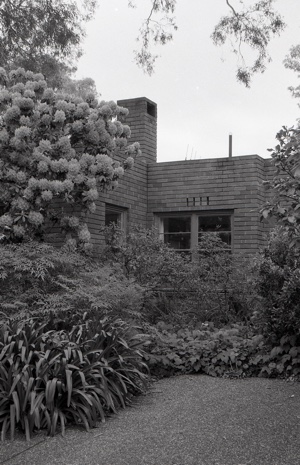3 Spencer Street, Turner (1946)

3 Spencer Street
3 Spencer Street, Turner was designed by husband and wife architects Malcolm Moir and Heather Sutherland in 1946. The house is a late example of the inter-war functionalist style with its asymmetrical massing, simple geometric shape and roof concealed by parapet.
This modern brick architecture was a continuation of Moir and Sutherland’s work from the period 1935–1939. It represents a more conservative approach to the functionalist style, with timber framed windows rather than metal, and a lack of corner windows. However, this may be due to a shortage of building materials in the period immediately after WWII, when there were restrictions placed on the use of steel.
Significance
3 Spencer Street, Turner is listed on the ACT Chapter of the Australian Institute of Architects Register of Significant Twentieth Century Architecture. The house is regarded by the AIA as a good, late example of the inter-war functionalist style. Despite the various alterations to the house, it still incorporates most of the principal elements of the inter-war functionalist style. It was probably the last inter-war functionalist house built in Canberra.
Description
The cavity brick house is constructed of brown face bricks with flush vertical joints and raked horizontal joints. The roof is a low pitched metal roof hidden by a low brick parapet. This has the effect of emphasising the horizontal plane. The windows are mostly double hung with green painted timber frames. A number of the original internal elements including joinery, ceilings and features such as Art Deco door handles remain and are in good condition.
The elongated plan of the house extends along a north/south axis with a central entry. A large front terrace extends across the two north east bedrooms while the lounge/dining room projects out to the front, at the southern end of the terrace, providing a protected approach to the entrance. South of the lounge/dining is a dinette, east of the kitchen, which faces west. The northern part of the house contains the two bedrooms and the wet areas. The main bedroom extends across the north side with extensive glazing to the north and west with a smaller window to the east.
The original residence had a roofed court to the west of the entry which was an important feature. The wall here was fully glazed to the west, so that upon entry, one was afforded a view through the house to the courtyard and beyond to the rear garden with the hall lit with natural light. However, an unsympathetic living room extension was placed into the courtyard area and into the rear garden. The main bedroom was also enlarged by glazing the original north west sleep out and removing the wall. The original glazing on the front eastern facade had the same low level sills; both the eastern bedrooms have had their sills raised.
Source
- Australian Institute of Architects RSTCA Citation No. R130